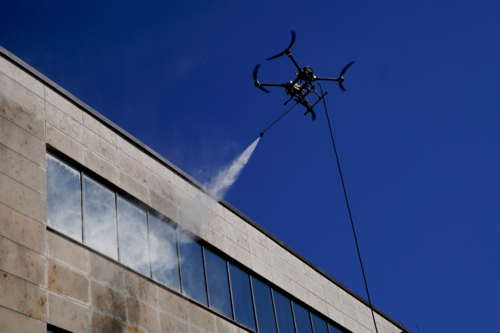Maintaining cleanliness in industrial buildings, factories, and office complexes is essential for both safety and aesthetics. However, traditional cleaning methods often fall short when it comes to reaching difficult or elevated areas. Cranes, scaffolding, or professional rope access technicians are typically required, leading to high costs and increased risk. To address these challenges, companies are turning to innovative solutions such as solar panel cleaning drones, which offer efficient and safe alternatives to manual cleaning methods.
How drone-powered high-pressure cleaning works
ABZ Innovation’s C10 drones are engineered to carry high-pressure cleaning systems to heights and areas that are otherwise difficult to access. The C10 model, for instance, can lift a high-pressure cleaning wand up to 30 meters, operating at a flow rate of 15 liters per minute with 190 bars of pressure. This makes it ideal for cleaning industrial surfaces such as office buildings, factories, and warehouses. Unlike conventional cleaning equipment, these drones are operated remotely, eliminating the need to place workers in potentially hazardous situations.
The benefits of drone-assisted cleaning solutions
One of the primary benefits of drone-assisted cleaning is the ability to reach high or complex areas that traditional equipment struggles with. High-rise buildings, intricate architectural designs, and machinery-dense industrial sites can be cleaned effectively without scaffolding or expensive lifting systems. A solar panel cleaning drone offers the mobility needed to perform cleaning tasks more quickly, enabling large surface areas to be covered in a fraction of the time.
Boosting efficiency while reducing operational costs
A reliable drone distributor plays a vital role in equipping businesses with advanced cleaning technologies. Investing in drone-based cleaning systems can significantly lower operational costs. The C10 drones can be deployed rapidly, reducing the time and expense involved in setting up cranes or scaffolding. Furthermore, automating cleaning processes helps cut labor costs and allows staff to focus on higher-priority facility management tasks.
Improving safety and minimizing risk
Traditional high-rise cleaning methods come with considerable safety risks, including falls and structural instability. Drones eliminate the need for workers to operate at dangerous heights, drastically improving workplace safety. Additionally, ABZ Innovation’s drones are equipped with radar systems that maintain a safe distance from building surfaces, helping to prevent accidental damage or collisions.
Versatility and adaptability in industrial cleaning
Drone technology offers remarkable versatility, making it suitable for a wide range of cleaning applications. ABZ Innovation’s C10 drones can be equipped with different high-pressure systems, allowing them to adapt to various cleaning needs. Whether addressing delicate surfaces or removing heavy industrial grime, these drones can be fine-tuned for optimal results. This flexibility allows businesses to maintain different structures effectively without needing multiple specialized cleaning solutions.
Meeting the growing demand for modern cleaning technologies
As industrial facilities and infrastructure become more complex, the demand for efficient and forward-thinking cleaning solutions continues to rise. Drone distributors are helping businesses embrace more sustainable and cost-effective practices by providing high-performance drone technology. Companies like ABZ Innovation are leading the way, delivering advanced drone solutions that increase cleaning efficiency while supporting environmental responsibility.
Final thoughts
The integration of drone-based cleaning systems marks a significant advancement in industrial and building maintenance. With the use of solar panel cleaning drones and high-pressure technology, businesses can enhance efficiency, reduce expenses, and improve safety for their workforce. As demand grows for smarter cleaning solutions, drone providers like ABZ Innovation are setting new standards by offering effective, versatile, and sustainable alternatives to traditional methods.










